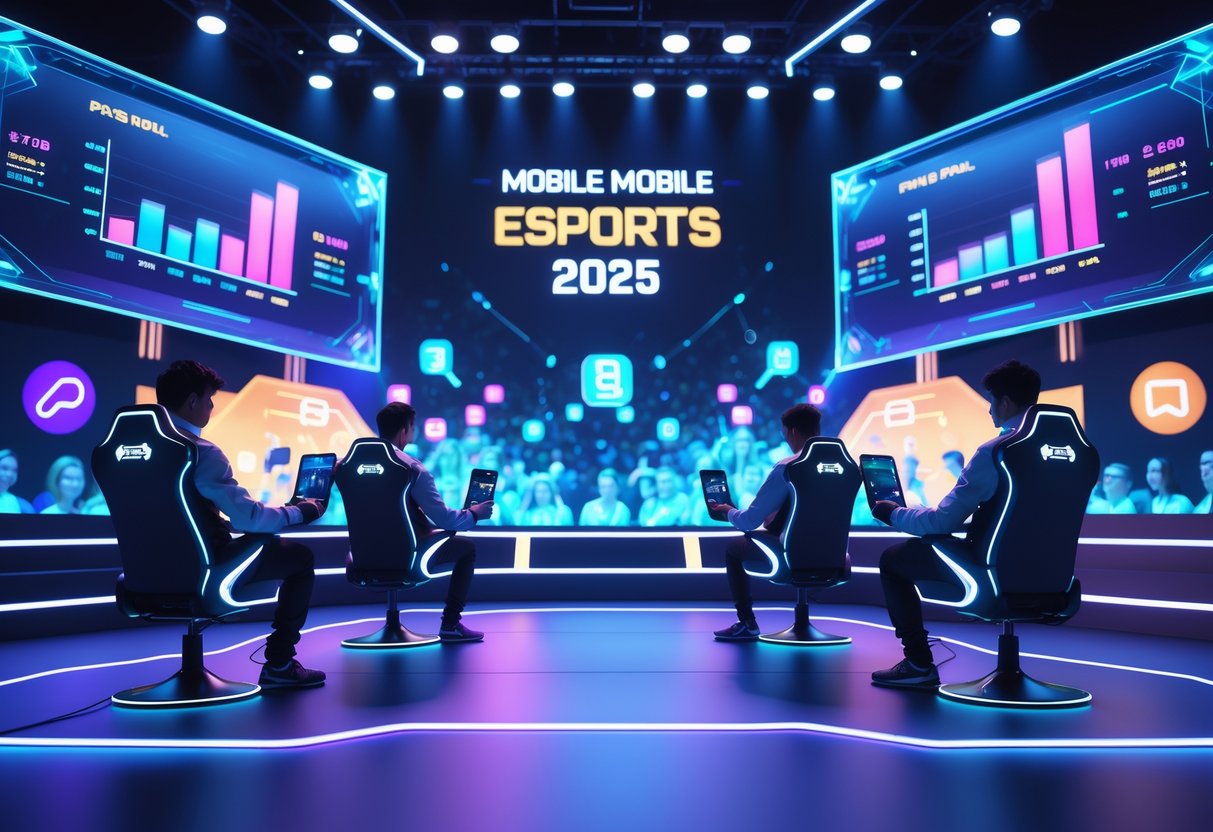Mobile Esports Prize Pools 2025: Biggest Games, Tournaments & Insights
Updated On: November 29, 2025 by Aaron Connolly
Top Mobile Esports Prize Pools in 2025
Mobile esports tournaments now throw around prize pools that rival some of the biggest PC competitions. Some events are topping £3 million, which is honestly wild.
The Esports World Cup went all in, dedicating £55 million across a bunch of titles—mobile games included.
Leading Mobile Games by Prize Money
PUBG Mobile keeps leading the pack in mobile esports earnings. The PUBG Mobile World Invitational 2025 put up a £3.2 million prize pool, making it the biggest mobile tournament this year.
Honor of Kings isn’t far behind. They’ve paid out over £16 million across 85 tournaments in 2024. The 2025 Invitational Season 3 hit a peak of 380,000 viewers, which really shows how huge it is in Asia.
Mobile Legends: Bang Bang still holds strong. The M5 World Championship gave away £1.2 million, and the game’s now expanding into Latin America and Africa. That global push is starting to pay off.
Free Fire World Series 2025 brought a £1.6 million prize pool to the table. Even with some regulatory headaches in certain regions, it’s still massive in Brazil and Southeast Asia.
Valorant Mobile jumped into the scene with £600,000 in its First Strike Series. Riot Games really pushed it hard, cross-promoting with the PC version, and it’s catching on surprisingly fast.
Record-Breaking Tournaments
The Esports World Cup 2025 in Riyadh basically rewrote the rulebook for mobile esports investment. £55 million spread across 25 titles—mobile games finally got a seat at the big kids’ table.
Brawl Stars World Championship 2024 did something different. Fans crowdfunded an £800,000 prize pool by buying in-game skins, which is proof people will put their money where their hype is.
We’re now seeing individual mobile tournaments regularly break the £1 million mark. In 2025, twelve events crossed that line—just a couple years ago, only four managed it.
Clash Royale World Finals kept a steady climb, offering £400,000 in prizes. They added AI coaching features, which is honestly pretty cool for a game that’s been around eight years.
Comparisons with Previous Years
Mobile esports prize pools have exploded—up 340% since 2022. Total tournament earnings for mobile hit roughly £45 million in 2025, compared to just £13 million three years ago.
Regional shifts are shaking things up. Asia still leads with 60% of prize money, but Latin America and the Middle East now combine for 25%, up from only 12% in 2023.
Developer investment is way up. Tencent, Moonton, and Garena fund regional qualifiers year-round, not just the big championships.
The gap between mobile and PC esports is shrinking fast. Mobile tournaments averaged £890,000 in prizes this year, while PC events averaged £1.4 million. That’s the closest it’s ever been.
Sponsorship growth is off the charts. Qualcomm, ASUS ROG, and OnePlus have tripled event budgets. Brand partnerships now make up 45% of prize pools, up from just 20% in 2022.
Breakdown of Major Mobile Esports Titles

Three mobile games have really shaped the competitive scene, each with huge prize pools and global fans. PUBG Mobile leads with massive international tournaments. Mobile Legends dominates Southeast Asian markets. Honor of Kings owns the lucrative Chinese scene.
PUBG Mobile: Global Impact
PUBG Mobile turned battle royale into a legit esports spectacle. Krafton’s mobile version now generates some of the biggest prize pools in competitive gaming.
The PUBG Mobile Global Championship sits at the top. Back in 2021, it gave out $6 million in prize money, making it one of the richest mobile esports events ever.
Prize pools have just kept going up:
- 2020: $1.2 million (Season 0 Finals)
- 2021: $6 million (Global Championship)
- 2024: Over $16 million across all events
Regional diversity really sets PUBG Mobile apart. Teams from Southeast Asia, China, Europe, and the Americas battle it out regularly. This global reach draws in sponsors and broadcasters from everywhere.
The Chinese version, Peacekeeper Elite, runs its own competitions. Peacekeeper Elite League Season 3 reached $3.1 million in prize money, showing regional versions can thrive right alongside the global one.
Mobile Legends: Bang Bang Success
Mobile Legends: Bang Bang rules the MOBA scene on mobile. Its biggest fans are in Southeast Asia—especially Indonesia and the Philippines.
MPL (Mobile Legends Professional League) tournaments drive most of the action. MPL Indonesia Season 8 had a $300,000 prize pool, the biggest among all regional leagues at the time.
A few things make it work:
- Low system requirements—runs on even budget phones
- Short matches—usually 15-20 minutes per game
- Regional focus—tournaments in local languages, with local teams
The esports model is different from Western games. Regional leagues feed into bigger international events, so teams have a clear path to the top. This keeps local fans invested.
Viewership numbers go through the roof for big tournaments. The mix of easy-to-pick-up gameplay and strong regional identity makes Mobile Legends a sponsorship magnet.
Honor of Kings and International Recognition
Honor of Kings stands as Tencent’s most successful mobile esports project. The prize pools are huge, mostly thanks to the Chinese market.
The Honor of Kings World Champion Cup 2021 put up $7.7 million in prizes. QG Happy, the winners, took home $3.2 million—one of the biggest single payouts in mobile esports.
Market positioning makes Honor of Kings unique:
- Huge Chinese audience with serious spending power
- Integration with Arena of Valor for global tournaments
- Sponsorships from major Chinese brands
The Arena of Valor World Cup 2022 merged both games, with an $8 million prize pool. Tencent uses this to reach international fans while keeping Honor of Kings strong at home.
Revenue generation goes beyond just prize money. These tournaments pull in premium ad rates, thanks to a wealthy viewership in China’s biggest cities.
Noteworthy Mobile Esports Tournaments in 2025

The biggest mobile esports tournaments in 2025 are putting up record-breaking prize pools. Events like PUBG Mobile’s world championship and Mobile Legends tournaments are pulling in millions of viewers across Asia, Latin America, and more.
PUBG Mobile Global Championship
The PUBG Mobile World Invitational (PMWI) 2025 is the top battle royale tournament this year, with a £3.2 million prize pool. Riyadh, Saudi Arabia, hosted 20+ teams from every major region.
PMWI’s global reach is honestly impressive. Teams from China, South Asia, and the Middle East usually dominate. The event runs over several weeks with multiple stages.
Key Tournament Details:
- Prize pool: £3.2 million
- Teams: 20+ international squads
- Location: Riyadh, Saudi Arabia
- Peak viewership: Over 1.2 million concurrent viewers
Production quality is top-notch. There’s professional commentary, tons of player stats, and stadium crowds that feel just as hype as any big gaming event.
Mobile Legends: Bang Bang MPL
The Mobile Legends Professional League (MPL) leads into the M5 World Championship, which gave out £1.2 million in 2025. Blacklist International and ONIC Esports keep setting the bar for competition.
MPL isn’t just for Southeast Asia anymore. The 2025 season added qualifiers in Latin America and Africa, so the game’s global footprint is only getting bigger.
Regional MPL Highlights:
- MPL Indonesia: Still the toughest league with 8 teams
- MPL Philippines: Home of the reigning world champs
- MPL Malaysia: Growing fast with more local sponsors
- MPL Brazil: New scene, but already attracting top Latin American talent
The league runs all year, split into seasons. Each region crowns a champ before the global finals.
Honor of Kings Invitational Events
Honor of Kings shocked everyone with over £16 million across 85 tournaments in 2024-2025. The 2025 Invitational Season 3 hit 380,000 concurrent viewers.
The game still focuses mostly on China, but it’s starting to branch out. Prize pools are just massive, thanks to a huge player base and big sponsorships.
Tournament Structure:
- 85+ events each year
- Seasonal invitationals
- Regional qualifiers
- International expansion in the works
So many tournaments mean lots of chances for players to go pro. More teams and coaching staff are popping up here than in any other mobile esport.
Regional and Emerging Competitions
Free Fire World Series 2025 put up £1.6 million in prizes, keeping its grip on Brazil and India. The Esports World Cup in Riyadh included mobile games in its massive £56 million total prize pool.
Valorant Mobile launched its competitive circuit with £600,000 in prize money. Riot Games is moving fast, building on the PC version’s success.
Emerging Regional Scenes:
- Latin America: LOUD and INFINITY are top dogs in Free Fire
- Middle East: Government-backed leagues with big budgets
- Africa: New tournaments for Mobile Legends and Free Fire are starting up
Clash Royale still has an active scene. The 2025 World Finals paid out £400,000, showing mobile esports can stick around for years.
These regional events give players a shot at the big leagues. Plenty of top pros started in local tournaments before getting picked up by big organizations.
Prize Pool Growth Trends Across Mobile Esports

Prize pools in mobile esports keep growing, thanks to three main funding sources. Publishers put in big money, communities chip in with in-game buys, and regional markets each have their own patterns.
Community and Publisher Contributions
Publishers like Tencent have seriously ramped up their investment in mobile esports. Honor of Kings hit a $10 million prize pool in 2024, which puts it on par with some PC tournaments.
Krafton, who runs PUBG Mobile, keeps raising tournament funding. They drop millions every year to stay competitive with PC titles.
Publishers usually outspend the community when it comes to funding mobile tournaments. That’s a bit different from PC esports, where crowdfunding is a bigger deal.
Direct publisher investment brings stability. Teams can actually plan their seasons, knowing prize pools won’t suddenly shrink if sales dip.
Big prize pools double as marketing. Huge tournaments grab headlines and pull in new players.
Crowdfunding and In-Game Revenue
Mobile games rake in cash with battle passes and cosmetic sales tied to tournaments. Players buy special items, knowing some of that money boosts the prize pool.
Honor of Kings ran limited-time skins to raise extra funds. Mobile Legends does something similar, offering exclusive character designs.
In-app purchases jump during tournament windows. Fans love supporting their favorite teams by grabbing branded content.
Mobile crowdfunding works differently than on PC. Fans buy stuff on their phones during matches, not on some separate platform.
Revenue from these tournaments often ends up higher than the original prize pool. Publishers love it—player engagement goes through the roof.
Regional Investment Patterns
Asian markets are leading the way in mobile esports investment. China and Southeast Asia are really pushing growth, while Western publishers like EA scramble to boost their mobile tournament funding and stay in the race.
Chinese companies have already thrown over $50 million into mobile esports prize pools in 2024. Big titles like Honor of Kings and Arena of Valor are at the center of this surge.
Over in Europe and North America, mobile tournaments just don’t get the same financial love. Their prize pools barely crack $1 million, while Asia hosts multi-million pound events almost routinely.
Regional sponsors play the game differently depending on where you look. Asian tournaments usually get money from telecoms and tech giants, but Western events lean on gaming brands for support.
Investment patterns usually mirror mobile gaming’s popularity. Countries that rake in high mobile gaming revenues tend to offer bigger tournament prize pools.
Comparison of Mobile and PC Esports Prize Pools

Mobile esports have come a long way. They’ve grown from tiny tournaments to matching—and sometimes beating—traditional PC prize pools. Some events now cross the £6 million mark.
PC esports still rule when it comes to the single biggest prizes. But mobile tournaments are closing the gap, thanks to steady investment and huge player numbers.
PC Esports Leaders: Dota 2 and Counter-Strike
Dota 2’s The International sets the bar for esports prize pools. The tournament keeps smashing records. The International 10 hit £40 million, mostly through community-backed battle passes.
Counter-Strike spreads out its prize distribution across lots of events. CS2 tournaments in 2025 have already handed out over £9.2 million at major events. Valve’s support and circuits like ESL Pro League keep the money flowing.
Other PC titles do things differently. League of Legends focuses more on stable salaries than giant prize pools. Valorant and Apex Legends are still building up their competitive scenes.
Key PC advantages:
- Longer tournament histories
- Established sponsorship networks
- Community funding systems
- Multiple revenue streams
How Mobile Rivals Traditional Esports
Mobile esports are catching up fast, mostly because of big corporate investments. Arena of Valor’s World Cup 2022 put up £8 million, and Honor of Kings hit £10 million in 2024.
Mobile prize pools keep growing. PUBG Mobile Global Championship 2021 split £6 million between teams. Call of Duty Mobile doubled its prize pool to £2 million in just two years.
Mobile tournaments get their funding in different ways. Publishers like Tencent pour in money to make their games competitive right away. It gives them instant credibility.
Mobile advantages:
- Direct publisher investment
- Huge player bases
- Growing viewership
- Lower entry barriers
Prize Distribution Across Esports Ecosystems
PC esports usually pack their prizes into fewer but bigger events. Dota 2 gives out one giant payout each year. Counter-Strike spreads the money across majors and smaller tournaments.
Mobile esports take a broader approach. Mobile Legends runs lots of regional leagues with steady prize pools. Free Fire hosts continental series in different regions at the same time.
Regional differences really stand out:
- Asian mobile tournaments often outdo Western PC events
- Chinese tournaments like Peacekeeper Elite League pay out £3.1 million locally
- European CS2 majors stick to traditional prize models
Mobile publishers keep investing aggressively in competitive scenes. It’s likely that mobile tournaments will match or beat traditional PC prizes soon—especially in Asia, where mobile gaming rules.
Regional Distribution of Mobile Esports Winnings

Most mobile esports prize money flows through Asia-Pacific. China and Southeast Asia take the biggest tournament payouts by far.
India’s rapid growth and new investment in Latin America, MENA, and Europe are starting to shift where the money ends up.
Asia-Pacific Market Dominance
China sits at the top for mobile esports winnings. Huge tournaments like Honor of Kings championships and PUBG Mobile events keep Chinese teams winning 40-60% of the biggest prize pools.
South Korea and Japan aren’t far behind. They’ve built strong Mobile Legends: Bang Bang (MLBB) and Free Fire scenes. The MPL (Mobile Premier League) tournaments in Southeast Asia hand out millions every year to players in Indonesia, Malaysia, and Thailand.
PUBG Mobile’s largest payouts land in this region. Teams from Asia-Pacific dominate international championships, so prize money cycles back into better training and organizations.
Quick win: Check out MPL Indonesia highlights to see how investment really boosts player skills.
The infrastructure edge is obvious. Big sponsors like Tencent and regional telecoms fund leagues year-round, so Asia-Pacific players get more chances to earn.
Growth in Latin America, MENA, and Europe
Brazil leads Latin America in mobile esports earnings, thanks to Free Fire championships. The Free Fire World Series gives out seven-figure prize pools, and Brazilian teams grab a good chunk of that.
Mexico and Argentina are also heating up in PUBG Mobile competitions. Prize pools in these regions have doubled since 2024.
The Middle East and North Africa are picking up speed too. Saudi Arabia invests in mobile tournaments, opening up new earning opportunities across MENA.
Europe is still behind, but there’s hope. Countries like Turkey and Germany are putting money into mobile gaming infrastructure, though their prize pools can’t touch Asia-Pacific—yet.
Warning: Many Latin American players still deal with shaky internet during big tournaments, which hurts their shot at prize money.
India’s Rise in Mobile Esports
India is the fastest-growing mobile esports market for prize money. BGIS (Battlegrounds Mobile India Series) tournaments now top ₹2 crores in annual prizes.
Teams like Team SouL and Godlike Esports have gone from content creators to serious contenders. Indian teams now regularly reach PUBG Mobile global championship finals.
The numbers are wild—over 400 million mobile gamers in India. That brings in massive viewership, which attracts international sponsors and bigger prize pools.
Companies like PayTM and Dream11 back regular competitions. Their support means Indian players can actually earn steady income from mobile esports.
Streaming in local languages like Hindi, Tamil, or Telugu helps too. It draws in local sponsors, which means more prize money for Indian tournaments.
Influence of Prize Pools on Esports Teams and Players
Big prize pools change how mobile esports teams operate. Teams with access to larger tournaments can pay better salaries and attract top sponsors who want visibility at marquee events.
Player & Team Earnings
Prize money is the backbone of a pro mobile gaming career. The 2024 Honor of Kings World Championship dished out £8 million, giving winning teams life-changing payouts.
Top mobile esports players now pull in £50,000-£200,000 a year just from tournament winnings. PUBG Mobile Global Championship winners usually take home £150,000-£300,000 per team member.
Mobile Legends: Bang Bang pros see similar numbers. Major tournaments spread prizes across 16-32 teams, so even semi-finalists get £10,000-£25,000.
These earnings let players:
- Train full-time (no more side jobs)
- Upgrade their gaming setups
- Move into team houses for serious practice
Prize distribution isn’t the same everywhere. Some tournaments go all-in for the winner, while others split money among the top 8.
Sponsorship and Organisational Investments
Big prize pools pull in corporate sponsors who want their logos on jerseys and social media at major tournaments. Teams in £5 million+ events can charge top dollar for sponsorships.
Organisations spend more on teams that make it to big-money tournaments. Esports teams with consistent top-8 finishes usually get:
- Monthly salaries of £3,000-£8,000 per player
- Performance bonuses for good placements
- Equipment sponsorships worth £2,000-£5,000 a year
Esports tournaments with smaller prize pools just can’t draw those big sponsors. This makes the big events even bigger, while smaller competitions fall behind.
Mobile gaming sponsors especially love tournaments that stream everywhere. Honor of Kings and PUBG Mobile events often hit 50+ million viewers, which is a dream for global brands.
Impact on Team Strategies
Teams change their whole strategy based on prize structures. Huge prize pools make organizations poach star players, which drives up transfer fees.
Esports charts show teams spend 40-60% more on coaching staff for big tournaments. They hire specialist analysts and even sports psychologists.
Teams sometimes skip smaller tournaments to focus all their training on the majors. The risk feels worth it when first place pays £500,000 instead of £10,000.
Qualifying tournaments get more intense, since just making the main event means solid prize money—even if you go out early.
Some organisations run multiple rosters to up their odds in different tournaments. That approach works best for games with lots of big-payout events each year.
Role of Esports Organisations and Publishers
Game publishers and esports organisations are the real financial engines behind mobile prize pools in 2025. They’re pouring millions into tournaments and building strategies to grow competitive mobile gaming around the world.
Krafton and Tencent Initiatives
Krafton and Tencent are leading mobile esports funding with huge direct investments. Krafton put $4 million into PUBG Mobile World Invitational 2025, making it the biggest mobile tournament prize pool this year.
Tencent spreads its support across multiple titles. They fund Honor of Kings regional leagues all over Asia and back PUBG Mobile global circuits. Their playbook is about year-round competitive seasons, not just one-off events.
Both companies set up dedicated esports divisions in 2025. Krafton’s Mobile Esports Academy now trains pro players throughout Southeast Asia. Tencent rolled out the Global Mobile Gaming League with standardised prize pools.
Quick win: Follow @PUBGMobile and @HonorOfKings on social media for updates on new tournament funding and qualifiers.
EA and Riot Games Contributions
Riot Games jumped into mobile esports with Valorant Mobile in 2025. They brought their PC tournament know-how to mobile and set aside $750,000 for the First Strike Series, targeting regions where mobile gaming is huge.
EA’s mobile strategy is a bit different. They stick to franchises like FIFA Mobile instead of battle royales. Their investments are smaller but steady across regions.
Riot uses their League of Legends model for mobile. They fund regional leagues first, then build up to global championships. This helps pro mobile players earn money all year.
EA tries out cross-platform tournaments. Sometimes mobile and console players compete for the same prize pool, which is an interesting experiment.
Publisher Strategies for Prize Growth
Publishers have four main ways to boost mobile prize pools in 2025. Direct funding is still the top method—companies like Moonton put $1.5 million into the Mobile Legends: Bang Bang M5 Championship.
Crowdfunding through in-game purchases is a big driver too. Skins and battle passes themed for tournaments often double the prize pool in just weeks.
| Strategy | Example | 2025 Results |
|---|---|---|
| Direct Funding | PUBG Mobile tournaments | $4 million pools |
| In-game Sales | MLBB battle passes | 100% prize increases |
| Sponsor Partnerships | Qualcomm backing | Additional $500k-1m |
| Regional Investment | Local league funding | Year-round stability |
Hardware sponsors like Qualcomm, ASUS ROG, and OnePlus also chip in millions. They offer equipment sponsorships and performance bonuses for teams using their gear.
Warning: Sometimes publishers hype up prize pool announcements by counting projected crowdfunding totals that might not actually happen.
Viewership Trends and Popularity Metrics

In 2025, mobile esports viewership hit 640 million globally. More than half—about 56%—watched on their phones.
Peak numbers for individual tournaments now go beyond 380,000 concurrent viewers. The growing audience keeps pushing prize pools higher.
Peak and Average Viewership
Honor of Kings stands at the top for mobile esports viewership. Its 2025 Invitational Season 3 drew in 380,000 peak viewers.
That’s pretty wild, right? Mobile games are now giving PC titles a run for their money.
PUBG Mobile isn’t far behind. The World Invitational finals have pulled over 1.2 million concurrent viewers.
Mobile Legends: Bang Bang keeps climbing in Southeast Asia. Big tournaments there often reach 200,000 to 300,000 peak viewers.
Most people watch mobile esports for about 45-60 minutes per session. That’s a bit shorter than PC events, but folks tend to tune in more often.
According to Esports Charts, mobile games get the most viewers during evening hours in Asia-Pacific. Weekends? Expect viewership to jump 40% compared to weekdays.
Esports Charts Data Insights
Esports Charts tracks the popularity of all mobile titles. In 2024, Honor of Kings alone hosted 85 tournaments.
They’ve found that mobile esports is growing fastest in India, Indonesia, and Brazil. These three countries now make up 60% of mobile viewership growth.
Here’s what peak concurrent viewers look like by game in 2025:
- Honor of Kings: 380,000
- PUBG Mobile: 1,200,000
- Mobile Legends: Bang Bang: 280,000
- Free Fire: 250,000
Mobile viewers interact in chat and on social media 30% more than PC audiences. Esports Charts has seen this trend hold steady.
Most people discover tournaments through YouTube highlights and TikTok clips. Short-form content now brings in 70% of new mobile esports fans.
Impact on Future Prize Pools
Higher viewership brings bigger prize pools. Honor of Kings put up $20 million in 2024 after viewer numbers doubled.
Sponsors like Red Bull, Qualcomm, and OnePlus have boosted tournament funding as concurrent viewers climb.
Mobile viewership trends suggest:
- Major tournament prize pools could hit $5-8 million by 2026
- Regional leagues are attracting more sponsor money
- Even smaller games are getting a lift from overall mobile growth
By the end of 2025, total mobile esports prize money should pass $50 million globally. That’s a 300% jump from 2023.
Organizers now plan events around peak viewing windows in key markets. This helps them maximize both live audiences and sponsor value.
Challenges and Opportunities in Mobile Esports Prize Pools
Mobile esports deals with some unique headaches in prize pool distribution. But there’s also a ton of untapped growth, especially in emerging markets.
Complex regulations and questions about sustainability clash with big opportunities in new regions and changing tournament formats.
Regulatory and Organisational Barriers
Prize pool regulations create headaches for tournament organizers. Countries treat gaming competitions differently—sometimes as sports, sometimes as gambling, sometimes just entertainment—which leads to a mess of tax rules.
- Tax complications – Winners face anywhere from 0% to 45% tax, depending on where they live
- Age restrictions – Some areas ban under-18 players from winning money
- Banking barriers – Cross-border payments can get blocked or delayed
- Licensing requirements – Organizers need multiple permits across different regions
China’s strict gaming rules especially impact global tournaments. Publishers have to jump through a lot of hoops for approvals, which can delay events for months.
Tencent and other mobile game publishers spend a fortune on legal teams just to run international events. Sometimes, tournaments get cancelled just weeks before they’re supposed to start because of sudden rule changes.
This patchwork approach hurts player development. Talented competitors from emerging regions often can’t access prize pools thanks to banking issues or government policies.
Growth Potential in Underserved Regions
Africa and South America are sitting on huge potential for mobile esports prize pools. These places see more people getting smartphones, but tournament infrastructure still lags behind.
Emerging opportunities:
- Mobile-first markets – Places where people game mostly on their phones, not PC or console
- Youth demographics – Big populations under age 25
- Better internet – Improving connections make competitive play possible
- Local partnerships – Telecom companies are starting to sponsor regional tournaments
COD Mobile’s 2025 roadmap added Africa as a sixth international region. That could open the door for millions of new competitors who never had a shot before.
India’s a great example of fast growth. PUBG Mobile tournaments there jumped from ₹50,000 prize pools in 2019 to ₹2 crore championships by 2024.
Publishers are catching on—smaller regional tournaments help feed talent into bigger global events. We’ll probably see more tiered systems to bring players from underserved areas to the big stage.
Sustainability of High Prize Pools
Million-dollar mobile tournaments sound great, but can this model last? Publishers are still footing most of the bill, making prize pools dependent on company profits instead of sustainable revenue.
Sustainability challenges:
- Publisher dependency – Game developers fund most prize money, not sponsors
- Viewer monetisation – Mobile tournaments haven’t cracked advertising revenue like PC esports
- Regional profitability – Some markets just don’t make enough to support big prizes
- Economic downturns – Prize pools are often the first thing to get cut when budgets tighten
Honor of Kings’ $10 million championship is impressive, but it leans heavily on Tencent’s deep pockets. Sports-style models with big broadcaster deals and sponsorships are still just starting to show up in mobile esports.
New revenue streams are popping up:
- NFT integrations – Not a huge hit yet, but interest is growing
- Betting partnerships – Legal in some places, not everywhere
- Merchandise sales – Tournament-themed cosmetics are selling well
- Subscription models – Premium viewing experiences are starting to catch on
The best tournaments are starting to mix publisher money with outside sponsors and creative monetisation. There’s slow but steady movement toward prize pools that don’t rely only on game developers.
Looking Ahead: The Future of Mobile Esports Prize Pools

Mobile esports prize pools will probably triple by 2030. Tech giants and traditional brands are finally taking the sector seriously.
Streaming revenue, regional expansion, and new tournament formats are shaking up how prize money flows through mobile esports.
Predicted Trends Beyond 2025
Prize pool growth will speed up fastest in Southeast Asia and Latin America. These regions already rule mobile esports viewership, making them prime for sponsor cash.
PUBG Mobile tournaments could see $8-10 million prize pools by 2027. India, Indonesia, and Brazil have such massive player bases that bigger investments just make sense.
Mobile Legends prize pools will grow at a steadier pace. Their regional league structure means more consistent tournaments all year, not just one big event.
Cross-platform integration is going to give mobile prize pools a big boost. When Valorant Mobile players can play alongside PC players, organizers can combine prize money.
Tech companies—Qualcomm, MediaTek, Samsung—are pouring money into mobile gaming hardware. Their sponsorships should push prize pools even higher as they fight for esports marketing bragging rights.
Governments are getting involved, too. Saudi Arabia’s $4 million PMWI investment shows how some countries see esports as a tool for soft power and economic growth.
Innovations in Tournament Formats
Hybrid tournaments—part online, part offline—are becoming the norm. These cut travel costs but still keep live finals exciting.
Season-long leagues are edging out single-elimination events. Monthly prize distributions keep players motivated all year, not just for one big payday.
We’re seeing more community-funded prize pools. Mobile Legends, for example, lets fans buy tournament passes that directly add to the prize money.
Cross-regional tournaments are expanding fast. Latin American teams now play regularly in Southeast Asian leagues, which means even bigger global prize pools.
Battle pass integration is changing the funding game. Tournament-themed cosmetics can rake in millions, and that money goes straight into the prize pot.
Smaller micro-tournaments (£500-£2,000 prize pools) are popping up everywhere. These give semi-pro players a shot and serve as stepping stones to the big leagues.
Corporate team leagues are also on the rise. Companies are fielding internal mobile esports teams, creating new circuits with serious prize money—sometimes for business networking as much as competition.
Increased Mainstream Recognition
Traditional sports broadcasters are finally paying attention. Sky Sports and BT Sport now cover major mobile tournaments, and that brings in sponsor money from the world of regular sports.
Olympic consideration could be a game-changer for prize pools. The 2028 Los Angeles Olympics might feature mobile gaming, which would attract huge corporate investment.
Football clubs and Formula 1 teams are getting in on the action, too. Manchester City and Mercedes-AMG have launched mobile teams, bringing big sponsorship budgets with them.
Universities are jumping in as well. Scholarship programs for mobile esports are popping up across the UK and Europe, making mobile gaming a real career path.
Media coverage has shifted. BBC Sport now reports on major mobile esports results just like any other sport.
Celebrity involvement keeps driving attention. When footballers and musicians join in, their brands help pull in sponsors who want bigger prize pools.
Corporate diversity programs are starting to embrace mobile esports. Companies see the global accessibility of mobile gaming as perfect for inclusive sponsorship, which brings even more business investment into tournaments.
Frequently Asked Questions

In 2025, mobile esports prize pools hit new records. The Esports World Cup alone offered £3 million for top mobile games.
Players now actually make real money from prize winnings, sponsorships, and streaming across different mobile platforms.
What are the top mobile esports tournaments with the largest prize pools in 2025?
The Esports World Cup leads the way for mobile esports prize pools this year. Four mobile games split the top prize of £3 million: PUBG Mobile, Mobile Legends: Bang Bang, and Honor of Kings.
Call of Duty Mobile keeps its £1 million prize pool in 2025. The tournament runs two divisions—Legendary and Open—across six regions, including Africa, which is new this year.
Other big mobile tournaments include Free Fire events and various regional championships. Prizes range from £500,000 to £2 million, depending on the game and tournament size.
How have mobile esports prize winnings evolved over the past few years?
Mobile esports prize pools have exploded over the last few years. What started as small, local competitions now features multi-million pound tournaments that rival PC esports.
Adding mobile games to huge events like the Esports World Cup shows just how much things have changed. Since 2022, prize pools for top mobile titles have jumped by 200-300%.
Sponsorships and massive viewer numbers are fueling this growth. Mobile games attract millions of players worldwide, which tournament organizers and sponsors definitely notice.
Could you share some tips for teams looking to compete in high-stakes mobile esports competitions?
Pick one mobile game and really master it, instead of spreading your attention across lots of titles. Go for games with established tournament scenes, like PUBG Mobile or Mobile Legends: Bang Bang.
Build your team through ranked matches and local events first. The best teams usually practice together for 6-8 hours a day before even thinking about bigger competitions.
Watch pro matches and study what top teams do. Mobile esports often require different tactics than PC games, thanks to touch controls and shorter matches.
Start creating content and building your social media presence early. Teams with bigger followings tend to get better sponsorships and more invites.
What impact do large prize pools have on the mobile gaming community and industry?
Big prize pools make mobile gaming a legit competitive platform. Players can now chase mobile esports as full-time careers with real earning potential.
These prizes are drawing traditional esports organizations into the mobile scene. Major sponsors see mobile tournaments as valuable marketing opportunities, thanks to their massive global audiences.
Bigger prize money helps regional scenes, too. Countries with strong mobile gaming cultures can now host world-class tournaments and grow local talent.
Which mobile games are leading in terms of rewarding their esports players generously this year?
PUBG Mobile grabs the spotlight with its £3 million Esports World Cup prize pool. Organizers keep the tournament scene busy all year and cover lots of different regions.
Mobile Legends: Bang Bang matches that prize money at its biggest events. Its massive popularity in Southeast Asia seems to fuel even more investment in tournaments.
Honor of Kings hands out big prizes too, especially in Asian countries. Meanwhile, Call of Duty Mobile keeps up a steady stream of £1 million tournaments and runs regular seasonal competitions.
Free Fire keeps bumping up its prize pools, mainly in Latin America and India. If you’re an esports player, these games offer plenty of chances to earn serious money every year.
Are there any newcomers in the mobile esports scene that have made a splash with substantial prize offerings?
CrossFire mobile showed up at the Esports World Cup 2025 and dropped a massive £2 million prize pool. That’s honestly one of the biggest launch prizes I’ve seen for a new mobile esports game.
Fatal Fury: City of the Wolves jumped into the mobile esports ring with a £1 million tournament. It’s wild seeing classic fighting game mechanics finally make their way to mobile, especially with such strong competitive support.
A few new battle royale games also arrived in 2025, each offering six-figure prize pools right out of the gate. They’re clearly trying to shake up the scene and go toe-to-toe with the big names.
On top of that, regional mobile games keep popping up with hefty local prize pools. In some countries, these games run tournaments with prizes over £500,000 just to get their competitive communities rolling.

